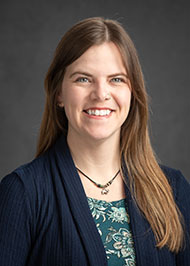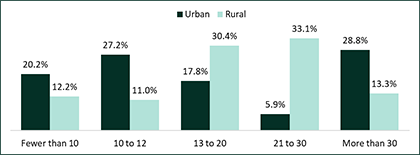Ask A Researcher
September 2024
Starting Out: Child care access in urban versus rural settings in North Dakota
 Kaeleigh Schroeder, MA, MSc, is a research specialist at the Center for Social Research, working on survey research projects and ND Compass. She has over a decade of research experience, starting in market research after receiving her Master’s degree in Sociology at the University of Manitoba. With experience in health care, publishing, and non-profit sectors, Schroeder has worked with a variety of research and data, and enjoys analysis of all kinds. Her most recent degree, a Master of Science in Business Analytics from North Dakota State University, is helpful as she contributes to new ND Compass data visualizations.
Kaeleigh Schroeder, MA, MSc, is a research specialist at the Center for Social Research, working on survey research projects and ND Compass. She has over a decade of research experience, starting in market research after receiving her Master’s degree in Sociology at the University of Manitoba. With experience in health care, publishing, and non-profit sectors, Schroeder has worked with a variety of research and data, and enjoys analysis of all kinds. Her most recent degree, a Master of Science in Business Analytics from North Dakota State University, is helpful as she contributes to new ND Compass data visualizations.
Acknowledgements
This article provides information on access to licensed child care providers in North Dakota, which was obtained from the survey of all licensed childcare providers in the state. This project was overseen by and completed on behalf of the North Dakota Department of Health and Human Services Child Care Assistance Program. For more information on the Child Care Assistance Program see https://www.hhs.nd.gov/applyforhelp/ccap
Introduction
Child care is an instrumental part of early childhood development, and has long been a key issue for families with working parents. When all parents in the household are working, access to quality child care becomes an important concern and necessity for a family. Recent data indicate that 71% of young children (younger than age 6) in North Dakota have all parents in a household working, which refers to both parents in married-couple families, or the mother or father in single-parent families (North Dakota Compass, 2024). For North Dakota’s school-aged children (ages 6 to 17), some of whom may need before- or after-school care, 78% of children have all parents working (North Dakota Compass, 2024). With these types of family employment scenarios, there are many considerations for child care: will there be child care outside of the home, or will a parent be able to stay home? Can another family member or friend provide care, or will parents seek a child care provider instead?
Finding options for licensed child care outside the home can be challenging. Long waitlists, limited provider options, early educational opportunities, and high costs have left parents with a care landscape that is difficult to navigate. In 2014, in an effort to mitigate some of these challenges, the federal government authorized the Child Care and Development Fund (CCDF) as part of the Child Care and Development Block Grant Act. The CCDF helps support low-income families seeking licensed child care by reimbursing the cost of care to providers.
As a part of the requirements for the CCDF funding in the state, the North Dakota Department of Health and Human Services contracted the Center for Social Research at North Dakota State University in 2023 to administer a survey of all licensed child care providers in the state. The survey helps to ensure that the assistance to families was accurately reimbursing child care providers for care; by assessing providers’ costs and rates, it also helps to evaluate the current state of licensed child care in North Dakota. This article provides information on access to licensed child care providers – capacity, wait lists and vacancies, and scheduling by urban and rural locations, which is a small part of the vast amount of information that was gleaned from the study.
Child care access by the numbers
Capacity
Residents of North Dakota know that the state is uniquely proportioned compared to many other states – there are distinctly urban areas, and vast rural areas. This contributes a great deal to the distribution of resources throughout the state, and rural residents face challenges with respect to access in many arenas, such as groceries, internet, and child care.
In September 2023, when the survey was launched, there were 1,172 licensed providers in the state. Of these, 29% were located in rural areas, which roughly aligns with the proportion of children aged 13 and younger in rural areas. According to the US Census Bureau, there were approximately 146,000 children 13 and younger in the state in 2021, 31% in rural areas. Urban areas accounted for the remaining 69% of children 13 and younger and 71% of child care providers in North Dakota (US Census Bureau).
The North Dakota Department of Health and Human Services has seven types of child care provider licenses under its oversight, and they fall into roughly two groups: family licenses (small-capacity providers who operate out of their homes) and center licenses (providers who operate larger-capacity facilities out of a non-residential space). A larger proportion of providers in urban areas were operating under center licenses than rural providers (31% compared to 19%, respectively). In contrast, a larger proportion of rural providers were carrying family licenses than urban providers (81% compared to 69%, respectively).
The average capacity for urban providers was split dramatically. In urban areas, child care providers with center licenses reported a much larger capacity than those with family licenses (97 to 13 on average). In rural areas, the difference in capacity between center and family license types is less (58 to 24 on average) (Table 1).
Table 1 : Average Capacity by Provider Type and Geographic Location

Average capacity aligns with license type: for providers with center licenses, capacity can be much higher. However, with family license types, capacity is often much smaller, and with a higher number of family licenses in urban areas, it is unsurprising to see a larger proportion of facilities with a capacity of fewer than 10 children (Figure 1).
Figure 1: Capacity Groupings by Geographic Location
Wait lists and vacancies
Securing a spot at a child care facility has been a long-standing challenge for families across the country; especially when needing an infant spot or spots for numerous children. Many parents anecdotally report being on multiple waiting lists, and some facilities have begun refusing to accept families who are not currently expecting a child. According to survey results, rural providers are more likely to have at least one child on a full-time or part-time wait list; 64% of responding providers in rural areas said there was at least one child on their full-time wait list (Figure 2).
Figure 2: Wait List Status by Geographic Location
While overall urban and rural providers reported few vacancies on average (four in urban and three in rural), vacancies were not spread evenly across license type (Table 2). Centers were more likely to report vacancies than those family licensed providers in both urban and rural areas (Figure 3).
Table 2: Average Number of Vacancies by Provider Type and Geographic Location

Figure 3: Vacancies by Provider Type and Geographic Location
Scheduling
Rural providers appear to have assumed the mantle of “jack of all trades” with schedules – while 50% of urban providers offer full-time care options only, 69% of rural providers offer full- and part-time schedules, giving more options to the families they serve (Figure 4). Rural providers are also significantly more likely to offer different schedule options such as drop-in care, before and after school care, and temporary or emergency care (Figure 5).
Figure 4: Weekly Care Schedule by Geographic Location
Figure 5: Additional Schedule Options by Geographic Location
What’s next for child care in North Dakota?
Meeting the child care demand has long been an issue in North Dakota, especially in rural areas. Managing inflation impacts, workforce participation, and access to child care services can be difficult for many in the state, and paints a complicated picture for families. Child care providers themselves, no matter where the location, also have challenges that they need to consider - staff, benefits, and changing demands of the industry. For instance, many providers now use child management software, including apps, to communicate daily with families and manage their businesses, but this requires up-to-date equipment and upskilling on potentially complicated programs. Additionally, the figures included above only show licensed providers, and do not take into account unlicensed providers or other types of child care, a hidden workforce playing a key role in supporting families and children.
As the child care industry continues to standardize, programs like Bright & Early ND, the state’s Quality Rating & Improvement System, help bring providers into a streamlined set of quality standards so that families know what to expect from their providers. Increased federal support like the CCDF continues to provide care options for families struggling to afford care, and helps the state’s economy by allowing parents to remain in the workforce – and providers to fill vacancies in their child care programs as need remains high.
Note:
Study results can be accessed through the NDSU Center for Social Research website, by clicking on the “North Dakota Child Care Provider Report: Market Rate and Narrow Cost Analysis Survey Findings” link found here: https://www.ndsu.edu/csr/research_and_evaluation/early_childhood/.
References
North Dakota Compass. (2024). Children with Working Parents. Retrieved August 29, 2024, from Early Childhood: https://www.ndcompass.org/early-childhood/key-measures.php?km=childrenwithworkingparents#0-8278-g
North Dakota Compass. (2024). Children With Working Parents. Retrieved August 29, 2024, from Early Childhood: https://www.ndcompass.org/early-childhood/key-measures.php?km=childrenwithworkingparents#0-8289-g
United States Census Bureau. (2024, June 27). County Population by Characteristics: 2020-2023. Retrieved August 20, 2024, from Census.gov: https://www.census.gov/data/tables/time-series/demo/popest/2020s-counties-detail.html
University of Wisconsin Population Health Institute. (2024). North Dakota. Retrieved August 20, 2024, from County Health Rankings & Roadmaps: https://www.countyhealthrankings.org/health-data/north-dakota?year=2024&measure=Child+Care+Cost+Burden*&tab=0
![]()
![]()





